(1 中国地质科学院矿产资源研究所 国土资源部成矿作用与资源评价重点实验室, 北京 100037; 2 中海油研究总院, 北京100027; 3 金堆城钼业集团有限公司, 陕西 华 县714102; 4 西安石油大学 地球科学与工程学院, 陕西 西安710065)
第一作者简介李洪英, 女, 1976年生, 博士, 高级工程师, 主要从事岩石学、矿物 学、矿床学研究。 Email: lihongyingy@163.com
收稿日期2015_09_17;
改回日期2016_03_24
本文得到中央级公益性科研院所基本科研业务专项资金“岩浆热液演化的包裹体证据_东秦 岭金堆城斑岩钼矿床熔融包裹体和熔融_流体包裹体研究(编号:YK1503)”、山西中条山 铜矿峪铜矿矿床地质特征及成因研究(编号: K1408)、中国地质调查项目“中国铜多金属 成矿规律、矿床模型和找矿方项研究(编号: 12120113093600)”和中国地质调查项目“ 重要矿种关键问题调查与矿产地质专题填图试点(编号: DD20160124)”的联合资助
its geological significance
(1 MLR Key Laboratory of Metallogeny and Mineral Assessment, Institute of Miner al Resources, CAGS, Beijing 100037, China; 2 Research Institute, CNOOC, Beijin g 100027, China; 3 Jinduicheng Molybdenum Group Co., Ltd.,Huaxian 714102, Sha anxi, China; 4 Earth Science and Engineering Couege of Xi an Shiyou University, Xi an 710065, Shaanxi, China)
基性岩脉是在大陆伸展背景下,主要来自地幔岩石圈或软流圈的岩浆侵入体,是地壳(或岩 石圈)伸展的重要标志,是地幔岩石圈部分熔融作用以及幔源岩浆作用的产物,所以许多与 地幔流体有关的矿床都和基性岩脉之前存在着一定的联系。研究表明,地幔流体为澳大利亚 Yilgarn地块太古宙金矿、中国内蒙古白云鄂博REE_Fe_Nb超大型矿床提供了成矿物质,又是 其成矿流体的重要来源;在胶东金矿、小秦岭金矿、华南铀矿带等成矿作用中,地幔流体起 着重要作用(王团华等,2008; 倪师军,1994;倪师军等,1994;孙丰月等,1995;胡瑞忠 等,1990;1993;胡瑞忠,1989;1990;李子颖等,1999;余达淦,1992;范洪海等,2003 ;张守本,2004;王学成,1986;1989;王学成等,1991;李献华等,1997;李献华,1990 )。在东秦岭地区许多金属矿床集中分布区域内,中基性岩脉也十分发育。因此,从20世纪 50年代末期以来,对该区的研究工作从未间断过(王艺芬等,1991;裴先志等,1995;2001 ;张本仁等,2000;宋峰等,1999;董云鹏等,1999;刘军锋等,2005;余研等,1994;倪 师军,1994;倪师军等,1994;王团华等,2008),但先前的研究主要着重于探讨基性岩脉 与各种金属矿化的关系,而对基性岩脉的岩石地球化学特征和成因的研究涉及较少,如王团 华等(2008)对小秦岭、熊耳山金矿区中基性岩墙的岩石化学进行了系统研究,倪师军(19 94)对小秦岭基性岩脉与金矿成因关系进行了研究,但是钼矿区基性岩脉的研究较少。金堆 城钼矿集区的基性岩脉主要为辉绿岩脉,仅在区域地质报告中有见报 道(陕西省地质局金堆城地质队,1959),而关于辉绿岩的形成时间、地球化学特征及其与 金堆城斑岩钼 矿的关系均未见到报道。因此,
本文对该区辉绿岩脉开展了系统的地球化学研究,并结合区 域上已 有的研究成果,对于基性岩脉成因机制及其形成时的地球动力学背景进行了探讨。
金堆城钼矿区位于陕西省东部,地处华北板块南缘的洛南_栾川台缘褶皱带西段。太古界太 华岩群片麻岩和混合岩出露于矿区的北部;中元古界熊耳群火山岩分布于矿区的中部_ 西 南部;中元古界官道口群高山河组不整合覆盖于熊耳群之上,其岩性主要为石英岩、板岩 和泥岩。金堆城矿区内断裂构造发育, 断裂构造主要为近东西向和北 西向2组,走向近东西的断裂有燕门凹张性断裂,它具多期活动的特点,形成一张性断裂破 碎带,南部为碌碡沟压性断裂,倾向南,北西向断裂倾向南西,近东西向断裂和北西向断 裂交汇处往往控制花岗斑岩和钼矿床的分布(陕西省地质局金堆城地质队,1959;黄典豪等 ,1987)。 褶皱构造主要为黄龙铺背斜,轴向与近东西向 的区域构造线相一致,核部由熊耳群火山岩组成,两翼和倾伏端由高山河组的石英岩、板岩 组成,东段轴向近东西向,在潘家沟一带呈略向南凸出的弧形。金堆城矿区内岩浆岩出露广 泛,印支期辉绿岩主要呈北东向或北西向脉状分布,燕 山期花岗岩呈两种形态产出,老牛山花岗岩体呈岩基大面积分布于矿区的西北部(图1)。
本区辉绿岩主要呈北东向、或北西向脉状 分布(图1),与矿区内燕山期二长花岗岩呈侵入接触关系,主要分布于新元古界官道口群石 英岩中。采样位置详见图1,岩石样品均有不同程度的蚀变(图2),主要呈灰黑色、灰黑绿 色 ;主要矿物有单斜辉石(35%)、基性斜长石(50%~60%),少量为石英(2%~3%)、磁铁 矿 、钛铁矿、磷灰石等。斜长石呈较规则板状、长条状,杂乱分布,格架中充填细粒辉石,构 成特征的辉绿结构,部分自形晶包嵌在辉石中,斜长石具有绢云母化、绿泥石化、钾长石化 ;辉石以半自形_他形粒状为主,不均匀地充填于斜长石的间隙中,多数发生蚀变,具有绿 泥石化等;石英呈微细粒状,不均匀地充填于斜长石、辉石的间隙中。
每个样品取约5 g用于主量元素和微量元素的测试。测试工作在国家地质实验测 试中心进行。主量元素除FeO、LOI采用标准湿化学分析方法外,其他元素分析采用XRF方法 完成,精度优于5%,稀土和微量元素采用ICP_MS方法分析,含量>10×10-6的元素 分析精度优于5%,含量<10×10-6分析精度优于10%。
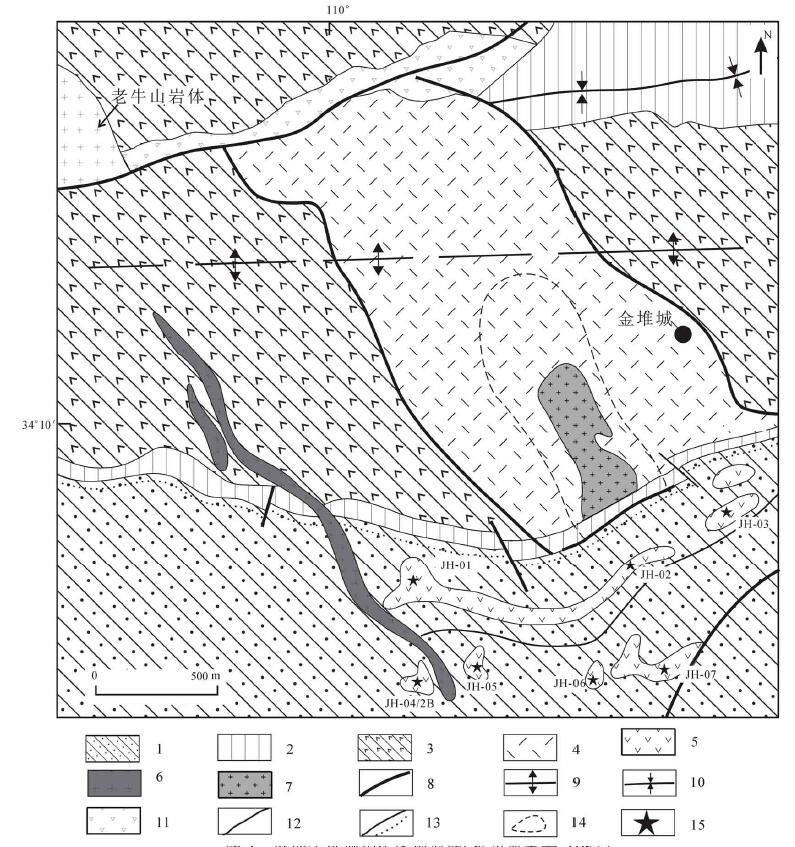
|
图 1陕西金堆城钼矿床地质图(据黄典豪等,1987)1—新元古界管道口群石英岩; 2—新元古界管道口群板岩; 3—古元古界熊耳群安山岩; 4—黑云母化安山岩; 5—辉绿岩; 6—燕山期二长花岗岩; 7—花岗斑岩; 8— 断层; 9—背斜轴; 10—向斜轴; 11—断裂破碎带; 12—地质界线; 13—不整合界线; 14—钼 矿体范围; 15—采样位置Fig. 1Geological map of Jinduicheng Mo deposit in Shaanxi (modified after H uang et al., 1987) 1—Quartzite and sandstone of Neoproterozoic Guandaokou Group; 2—Slate of Mesop roterozoic Xiong er Group; 3—Andesitic rocks of Mesoproterozoic Xiong er Group; 4—Biotitized andesite; 5—Triassic diabase; 6—Yanshanian adamellite; 7—Grani te porphyry; 8—Fault; 9—Anticline axis; 10—Syncline axis; 11—Fault z one; 12 —Exploration line; 13—Unconformity; 14—Mo orebody; 15—Sampling location |

|
图 2金堆城钼矿区辉绿岩特征 a. 花岗岩与辉绿岩接触带; b. 野外辉绿岩; c. 辉绿岩手标本; d. 绿泥石化辉绿岩 Pyx—辉石, Pla—斜长石, Chl—绿泥石化 Fig. 2Petrography of diabase dyke from the Jinduicheng Mo deposit a. Gontact zone of granite and diabase; b. Field photo of diabase; c. Diabase sa mple; d. Microscopic characteristics of diabase Pyx—Pyroxene,Pla—Plagioclase,Chl—Chloritization |
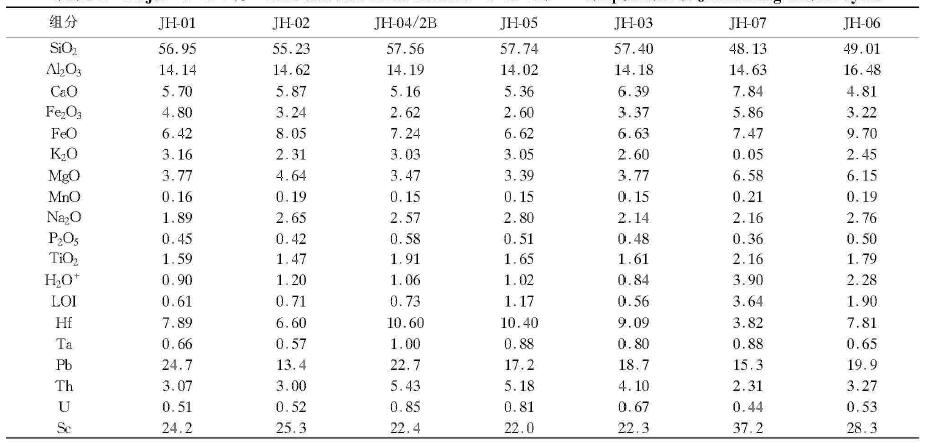
|
表 1金堆城辉绿岩脉的主量元素(w(B)/%)、微量元素和稀土元素(w (B)/10-6)分析结果 Table 1Major (w(B)/%),trace and rare earth elements (w(B)/10-6 ) compositions of Jinduicheng diabase dykes |
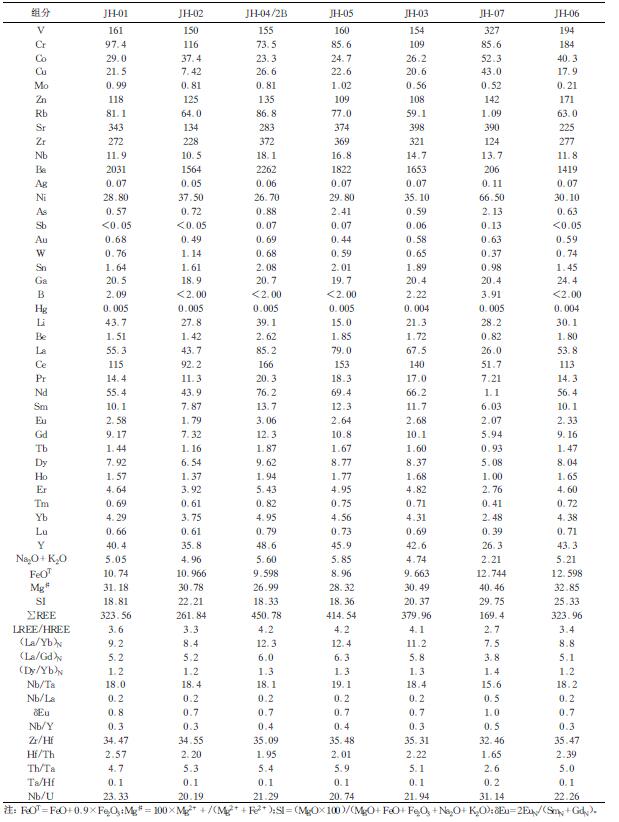
|
续表 1Continued Table 1 |
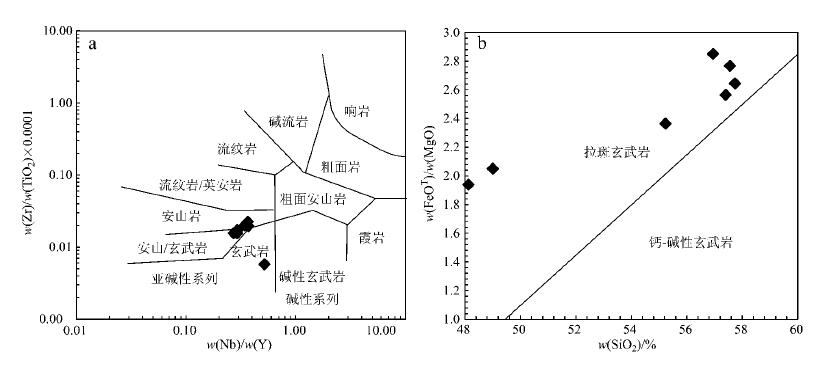
|
图 3金堆城钼矿床辉绿岩脉的岩石系列判别图 a. Zr/TiO2×0.001_Nb/Y图解(据Winchester et al.,1977); b. FeOT/MgO_SiO2 (Miyashiro,1975)图解 Fig. 3Discriminative diagrams for the mafic dykes in the Jinduicheng Mo deposi t a. Zr/TiO2×0.001 versus Nb/Y (after Winchester et al., 1977); b. FeOT/MgO v ersus SiO2 (Miyashiro,1975) |
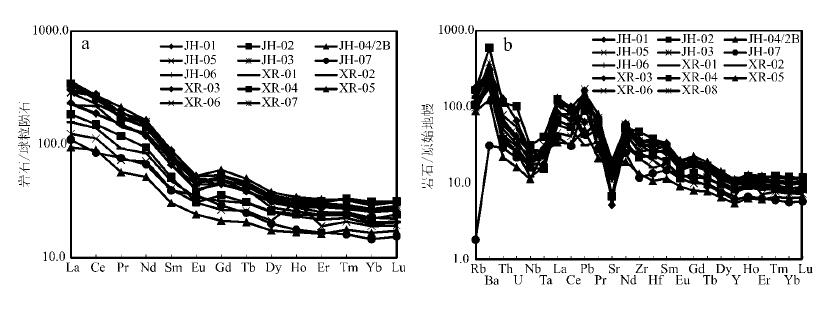
|
图 4金堆城钼矿床辉绿岩球粒陨石标准化稀土元素配分曲线(a)和微量元素原始地 幔标准化蛛网图(b)(球粒陨石 标准化值和原始地幔数据据Sun et al.,1989;图中XR_0 1~XR_07为熊耳群火山岩,数据引自赵太平等,2002) Fig. 4Chondrite_normalized REE patterns (a) and primitive mantle normalized tr ace element spidergram (b) for the mafic dykes in the Jinduicheng Mo deposit ( chondrite normalized values and primitive mantle data after Sun et al.,1989) |
岩脉的微量元素分析结果列于表1中,微量元素蛛网图见图4b。微量元素组成上,总体富集R b、Ba等大离子亲石元素,相对亏损Nb、Ta、Zr、Hf等高场强元素,而Sr相对相邻元素(Pr 和Nd)亏损((图4b)。岩脉的Nb/Ta比值为15.6~19.1,接近球粒陨石和原始地幔的Nb/ Ta 比值(约17.5),高于新太古代大陆地壳平均值(11~12)(Hofmann,1988;Green, 199 5)。
研究区辉绿岩脉总体亏损HFSE,富集LILE,有明显的Nb、Ta和Ti负异常以及Ba和Pb的正异常 ,La/Nb比值和La/Ta比值(分别为1.9~4.7和29.5~89.8)明显高于受地壳混染岩石的 相应比值(分别为>1.5和>30,Fitton et al., 1988; Thompson et al., 1988),说明金 堆城钼矿区辉绿岩脉形成过程中受到地壳混染。
金堆城钼矿床辉绿岩脉的后期蚀变比较明显,比如一些样品具有相对较高的LOI值(1.17% ~3.64%)和较多的蚀变矿物(如绿泥石、绿帘石等),有些薄片中的辉石全部蚀变为角闪石 。部 分岩石的蚀变程度较高,研究区内辉绿岩脉以Nb、Ta、Ti亏损为特征,表明有地壳物质或者 富集岩石圈地幔物质的贡献,可能是后期地壳混染的结果(AFC过程),也可能是源区混染的结果,有待进一步研究。
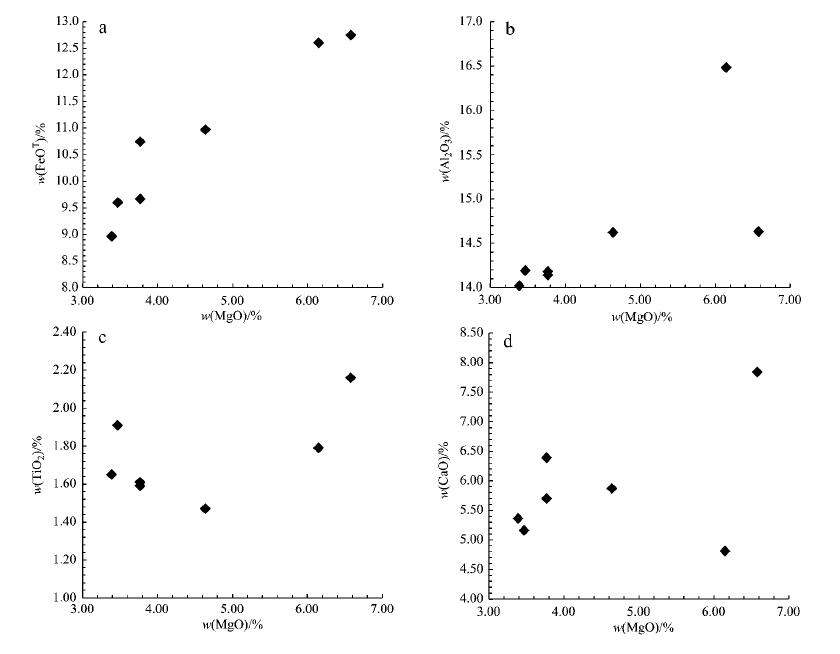
|
图 5金堆城钼矿床辉绿岩脉的Harker图解 Fig. 5Harker diagrams of the diabase dykes in the Jinduicheng Mo deposit |
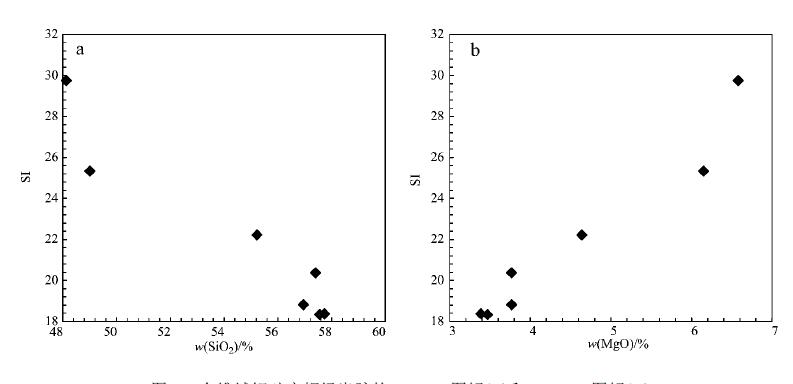
|
图 6金堆城钼矿床辉绿岩脉的SI_SiO2图解(a)和SI_MgO图解(b) Fig. 6SI versus SiO2 (a) and SI versus MgO (b) diagrams for the mafic dykes in the Jinduicheng Mo deposit |
金堆城钼矿区辉绿岩的稀土元素总量与熊耳群(ΣREE为334.46×10-6~463.6×10 -6,夏 林圻等,1990;赵太平等,2002)的相似,且均为轻稀土元素富集型(夏林圻等,1990;赵 太平等,2002),δEu微弱的负异常(夏林圻等,1990;赵太平等,2002),表明它们具有 相同的岩石 化学基本属性。从上可知,金堆城的辉绿岩类主要来源于上地幔部分熔融产生的碱性玄 武岩浆,但是受到陆壳物质的混染。
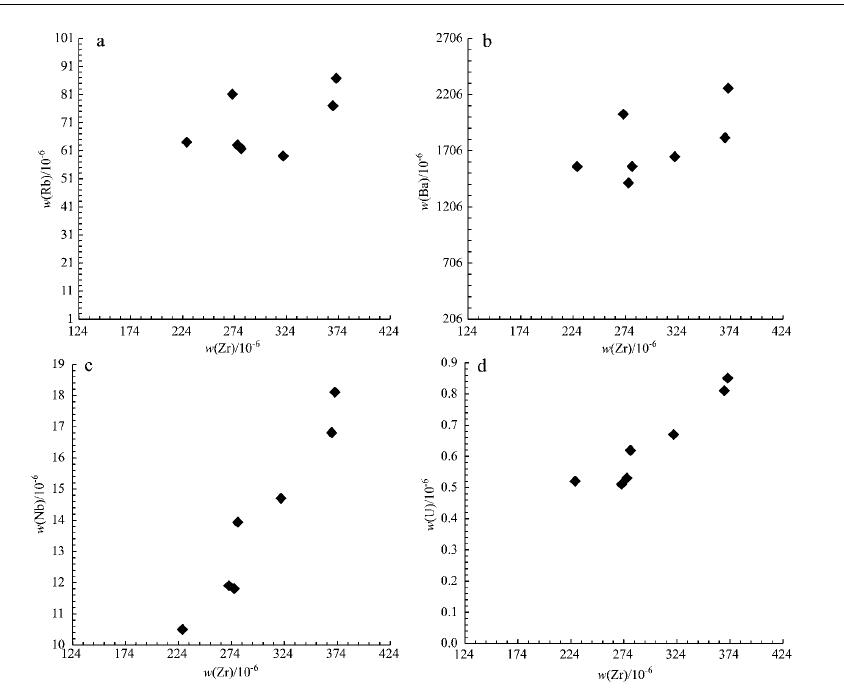
|
图 7金堆城钼矿区辉绿岩的Rb_Zr(a)、Ba_Zr(b)、Nb_Zr(c)和U_Zr(d)图解 Fig. 7lots of Rb_Zr (a), Ba_Zr(b), Nb_Zr(c) and U_Zr (d) of the Jinduicheng Mo deposit |
金堆城钼矿区辉绿岩脉的大离子亲石元素Sr、Ba和高场强元素Nb、Zr较富集,而稀土元素 Y和Yb相对亏损。辉绿岩脉的Hf/Th比值(1.65~2.57)相似于板内玄武岩(<8,Condie, 1989);辉绿岩脉的Th/Ta比值为2.6~5.9,Ta/Hf比值为0.1~0.2,与大陆板内玄武岩 的值(分别为>1.6和>0.1,汪云亮等,2001)相一致;Zr/Hf比值为32.46~35.48,Nb/ Ta比值为15.6~19.1,Nb/U比值为20.19~31.14,这些比值与大多数大陆板内拉斑碱 性玄武岩相似,相对都 比较稳定(罗金海等,2006)。上述微量元素特征显示,金堆城钼矿区的辉绿岩脉属于大 陆板内玄武岩范畴,形成过程中受到地壳物质的混染(李献华等,1997)。岩石的w( Cr)为85.6×10-6~184×10-6) (<200×10-6),表明岩浆早期有橄 榄石的分异作用。HFSE比值中的Zr/Nb比值为20.55~23.47(一个样品为9.05),普遍高 于原始地幔平均值(14.8),表明岩浆可能是地幔源区遭受地壳组分改造所致。
赵太平等(2002)研究认为熊耳群火山岩由玄武质_流纹质火山岩组成,并以玄武安山岩、 安山岩为主,次为英安_流纹岩,显示与拉斑玄武质岩浆及其演化趋势一致的特征,其岩石 化学成分的突出特点是高Fe、K,低Al、Ca和Mg,富集LILE和LREE,相对亏损HFSE,显示岛 弧型地球化学特征,可能是地幔源区遭受地壳组分改造所致。从地质特征来 看,
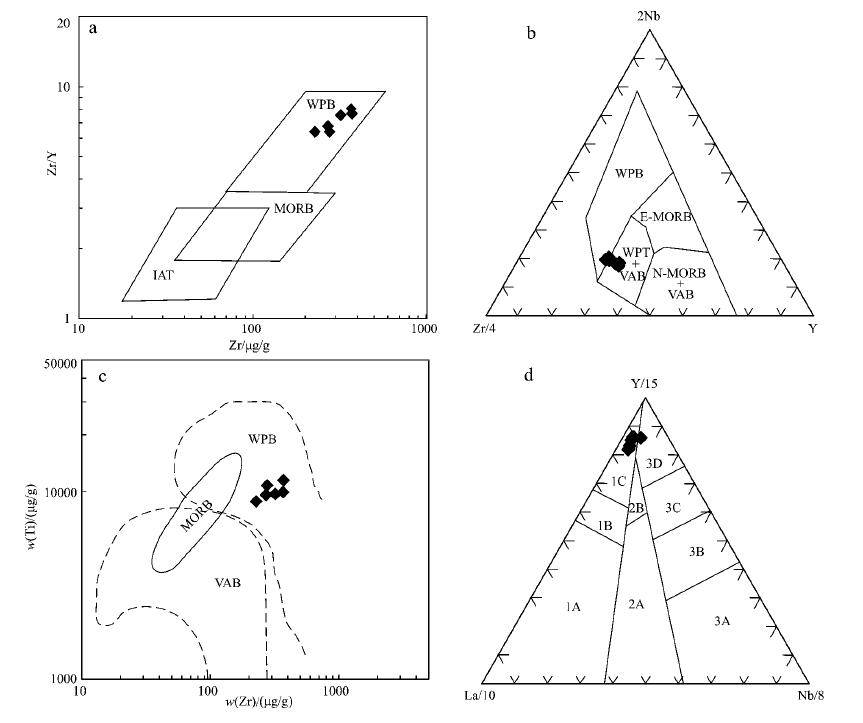
|
图 8辉绿岩微量元素构造环境判别图 a. Zr/Y_Zr(Pearce et al., 1979)图解; b. 2Nb_Zr/4_Y(Meschede,1986)图解; c. Zr_Ti(Pearce et al., 1979)图解; d. Y/15_La/10_Nb/8 (Cabanis et al., 1989)图 解 IAT—岛弧玄武岩; MORB—洋中脊玄武岩; WPB—板内玄武岩; E_MORB—富集型MORB; VA B—火山弧玄武岩; 1A—钙碱性玄武岩; 1B—1A和1C的重叠区域; 1C—火山弧拉斑玄武 岩 ; 2A—大陆玄武岩; 2B—弧后盆地玄武岩; 3A—大陆内裂谷区的碱性玄武岩; 3 B、3C—E型MORB(3B区是富集的,3C是弱富集的); 3D—N_MORB Fig. 8Tectonic discriminant diagrams for the diabase dykes a. Zr/Y_Zr diagram (Pearce et al., 1979); b. 2Nb_Zr/4_Y diagram (Meschede, 1986) ; c. Ti_Zr diagram (Pearce et al., 1979); d. Y/15_La/10_Nb/8 diagram (after Caba nis et al., 1989) IAT—Island_arc basalt, MORB—Mid_ocean ridge basalt, WPB—Intraplate basalt, E—MORB_enrichment_type MORB, VAB—Volcanic arc basalt, 1A—Calc_alkaine basal t, 1B—Transition region, 1C—Volcanic arc basalt, 2A—Continental basalt, 2B—A ckarc basin basalt, 3A—Continental rift alkaline basalt, 3B and 3C—E_type MO RB (3B—Enrichment, 3C—Slight enrichment), 3D—N_type MORB |
(2) 金堆城钼矿区的辉绿岩脉主要来源于上地幔部分熔融产生的碱性玄武岩浆,但是受 到陆壳物质的混染。
志谢野外工作得到金堆城钼业集团有限公司各位领导、专家的热心帮助;镜下 鉴定过程中得到了中国地质科学院矿产资源研究所向君峰和魏然的指导与帮助。在此一并表 示感谢。
Cao H J, Huang L Z, Shen W Z, Ling H F, Huang G L, Deng P and Zhu B. 2011. Geoch emical characteristics and genesis of Niudai diabase dykes in northern Guangdong Province[J]. Journal of East China Institute of Technology, 34(4): 323_331(in Chinese with English abstract).
Cao J J, Hu R Z and Xie G Q. 2009. Geochemistry and genesis of mafic dikes from the coastal areas of Guangdong Province, China[J]. Acta Petrologica Sinica, 25 (4): 984_1000(in Chinese with English abstract).
Chen Y J, Li C, Li Z and Wang H H. 2000. Sr_O isotopic characteristics, Genetic mechanism and types of granite_porphyry bodies for Mo mineral belt in Xiao Qinli ng[J]. Science in China (Series D) , 30(S): 64_73(in Chinese).
Cheng X J, Cheng J P and Wang J H. 1998. Element geochemistry of shoshonitic lam prophyres in the Pengjiakuang gold district, Shangdong Province, China[J]. Geo chimiea, 27(1): 91_100(in Chinese with English abstract).
Condie K C. 1989. Geochemical changes in basalts and andsites across the Archaea n _Proterozoic boundary: Iden tificatiion and significance[J]. Lithos, 23: 1_1 8.
Dong Y P, Zhou D W and Zhang G W. 1997. Geochemistry and formation setting of Fu shui complex, eastern Qinling[J]. Geochemica, 26(3): 79_88(in Chinese with Eng lish abstract).
Fan H H, Ling H F and Wang D Z. 2003. Study on metallogenetic mechanism of Xiang shan uranium ore_field[J]. Uranium Geology, 19(4): 208_213(in Chinese with Eng lish abstract).
Fitton J G, James D and Kempton P D. 1988. Th e role of lithospherie man tle in the generation of late Cenozoic basic magmas in the western United States[J]. Journal of Petrology, (Special volume): 331_349.
Gao S, Zhang B R and Jin Z M. 1999. The delamination of the lower crust in Qinli ng_Dabie orogenic belt[J]. Science in China(Series D), 29(6): 532_541(in Chine se).
Ge X Y, Li X H and Zhou H W. 2003. Geochronologic, geochemistry and Sr_Nd isotop es of the Late Cretaceous mafic dike swarmsin southern Hainan island[J]. Geoch emica, 32(1): 11_20(in Chinese with English abstract).
Green T H. 1995. Significance of Nb/Ta as an indicator of geochemical processes in the crust_mantle system[J]. Chemical Geology, 120: 347_359.
Halls H C. 1982. The importance and potential of mafic dyke swarms in studies of geodynamic process[J]. Geoscience Canada, 9(3): 145_154.
Halls H C and Fahrig W F. 1987. Mafic dyke swarms[C]. Geo1ogy Asotin Candy Spe ctor Paper, 34: l_503.
Hoek J D and Seitz H M. 1995. Continental mafic dykes swamis as tcctonic indicat ors: An example from the Vestfold Hills[J]. East Antarctica Precamb Resourse, 75(1): 121_139.
Hofmann A W, Jochum K P, Seufert M and White W M. 1986. Nb and Pb in oceanic bas alts: New constraints on mantle evolution[J]. Earth and Planetary Science Lett ers, 79(1_2): 33_45.
Hofmann A W. 1988. Chemical differentiation of the petrogensis of Mesozoic Gondw ana low_Ti flood basalts[J]. Earth and Planetary Science Letter, 90(3):297_314 .
Hofmann A W. 2003. Sampling mantle heterogeneity through oceanic basalts: Isotop es and trace elements[A]. In: Carlson R, ed. Treatise on geochemistry[C]. Pe gamon: Elsevier. 2: 61_101.
Hu R Z. 1989. Mineralizing mechanism of XW uranium deposit[J]. The Journal of Chengdu College of Geology, 16(3):1_9(in Chinese with English abstract).
Hu R Z. 1990. One possible metallogenic model of the granite_type uranium deposi t[J]. Chinese Science Bulletin, 35(7): 53_57(in Chinese with English abstract) .
Hu R Z and Jin J F. 1990. Mechanism of the migration and deposition of uranium i n ascending hydrothermal solutions: Evidence from the Xiwang Uranium deposit[J ]. Geological Review, 36(4): 317_325(in Chinese with English abstract).
Hu R Z, Li C Y and Ni S J. 1993. A study of origin for ΣCO2 of the hydrotherm al fluid in granite_type uranium deposit[J]. Science in China(Series B), 23(2) :189_196(in Chinese with English abstract).
Huang D H, Wu C Y and Nie F J. 1987. Geological feature and origin of the Jindui cheng porphyry molybdenum deposit, Shaanxi Province[J]. Mineral Deposits, 6(3): 22_34(in Chinese with English abstract).
Huang D H. 1989. Mineralogical characteristics of Ferrimolybdite from the Jindui cheng molybdenum deposit in Shaanxi Province and its significance[J]. Acta Pet rologica et Mineralogica, 8(4): 352_360(in Chinese with English abstract).
Huang D H. 1992. Rhenium content and polytype characteristics of molybdenite fro m molybdenum deposit in East Qinling[J]. Acta Petrologica et Mineralogica, 11( 1): 74_83(in Chinese with English abstract).
Huang D H, Wu C Y, Du A D and He H L. 1994. Re_Os isotope age of molybdenum depo sits in east Qinling and the significance[J]. Mineral Deposits, 13(3): 221 _230(in Chinese with English abstract).
Huang Z L, Liu C Q and Zhu C M. 1999. The origin of lamprophyres in Laowangzhai gold deposit, Yunnan Province and their relations with gold mineralization[M]. Beijing: Geological Publishing House. 30_112(in Chinese).
Jia D C, Hu R Z and Lu Y. 2003. Element geochemistry and tectonic setting of the basic rocks in Rucheng Basin, southeastern Hunan Province, China[J]. Geology_ Geochemistry, 31(2): 25_31(in Chinese with English abstract).
Kuno H, Yamasaki K, Lida C and Nagashima K. 1957. Differentiation of Hawaiian ma gmas[J]. Japanese Journal of Geography and Geology, 28: 179_218.
Le Bas N J, Le Maite R W and Streckeisen A. 1986. A chemical classification of v olcanic rocks based on the total alkali_silica diagram[J]. Journal Petrology, 27: 745_750.
Li H Y, Mao J W, Wang X X, Ye H S and Ma G W. 2011. Geochemistry and Sr, Nd, Pb isotopic characteristics of the granite in Jinduicheng ore concentration area[J ]. Geology in China, 38(6): 1536_1550(in Chinese with English abstract).
Li H Y, Ye H S, Wang X X, Yang L and Wang X Y. 2014. Geology and ore fluid geoch emistry of the Jinduicheng porphyry molybdenum deposit, East Qinling, China[J] . Journal of Asian Earth Sciences, 79:641_654.
Li X H. 1990. Genesis of mafic dykes in Zhuguangshan rock: Sr, Nd, and Pb isotop ic evidence[J]. Chinese Science Bulletin, 35(6):1247_1249(in Chinese with Engl ish abstract).
Li H Y,Wang X X,Ye H S and Yang L. 2012. Emplacement ages and petrogenesis of the molybdenum_bearing granites in the Jinduicheng area of East Qinling, China: Constraints from zircon U_Pb ages and Hf isotopes[J]. Acta Geologica Sinica (E nglish Edition),86(3): 661_679.
Li X H, Hu R Z and Rao B. 1997. Geochronology and geochemistry of cretaceous maf ic dikes from Northern Guangdong, SE China[J]. Geochimica, 26(2): 15_31(in Chi nese with English abstract).
Li Y F, Mao J W, Hu H B, Guo B J and Bai F J. 2005. Geology, distribution, types and tectonic settings of Mesozoic molybdenum deposits in East Qinling area[J] . Mineral Deposits, 24(3): 292_304(in Chinese with English abstract).
Li Z Y, Li X Z and Lin J R. 1999. On the Meso_cenozoic mentle plume tectonics, i ts relationship to uranium metallogenesis and prospecting directions in South Ch ina[J]. Uranium Geology, 15(1): 9_17(in Chinese with English abstract).
Liu C M, Lu X X and Zhang Z W. 1989. Geochemical characteristics of rare earth e lements for granitoid in East Qinling[J]. Henan Geology, 7(2): 32_39(in Chines e with English abstract).
Liu J F and Sun Y. 2005. New data on the “hot" emplacement age of ultramafic ro c ks from the Songshugou area in the eastern Qinling[J]. Geological Review, 51(2):189_192(in Chinese with English abstract).
Lu J J, Wu L Q, Lin H F, Shen W Z, Gao J F, Huang G L, Deng P and Tan Z Z. 2006. The origin of the Huangpi_Zhangguangying diabase dykes in the Xiazhuang uranium ore district of northern Guangdong Province: Evidence from trace elements and N d_Sr_Pb_O isotopes[J]. Acta Petrologlca Sinica, 22 (2): 397_406(in Chinese wit h English abstract).
Lu X X, Yu Z P, Feng Y L, Wang Y T and Ma W F. 2002. Mineralization and tectonic setting of deep_hypabyssal granites in East Qinling Mountain[J]. Mineral Depo sits, 21(2): 168_178(in Chinese with English abstract).
Luo J H, Che Z C, Zhou X Y, Li Y, Li J L and Zhang J Y. 2006. Diabase evidence f or the early Mesozoic extension in the western Tarim Basin,NW China[J]. Geolo gy in China, 33(3): 566_571(in Chinese with English abstract).
Luo M J, Zhang F M and Dong Q Y. 1991. The molybdenum deposits[M]. Zhengzh ou: Henan Science and Technology Publishing House. 1_235 (in Chinese).
Luo M J, Lin Q L, Lu X X and Chen T H. 1993. Geological characteristics of the m olybdenum_bearing granitoids in East Qinling[J]. Henan Geology, 11(1): 2_8(in Chinese with English abstract).
Mao J W, Li Y H and Li H Y. 1997. Helium isotopic evidence on metalgenesis of ma ntale fluids in the Wangu gold deposit, Hunan Province[J]. Geological Review, 43(6): 646_649(in Chinese with English abstract).
Mao J W, Li X F, Zhang Z H, Wang Y T, Li H M and Hu H B. 2003. Geology, distribu tion, types and tectonic settings of Mesozoic epithermal gold deposits in East C hina[J]. Geological Journal of China Universities, 9(4): 620_637.
Mao J W, Xie G Q, Pirajino F, Ye H S, Wang Y B, Li Y F, Xiang J F and Zhao H J. 2010. Late Jurassic_Early Cretaceous granitoid magmatism in Eastern Qinling, cen tral_eastern China: SHIMP zircon U_Pb ages and tectonic implications[J]. Austr alian Journal of Earth Sciences, 57: 51_78.
Mc Neil A M and Kerrich R. 1986. Archean lamprophyres dikes and gold mineralizat ion, Matheson Ontario: The conjuction of LREE_enriched magmas, deep crustal stru ctures and Au concentration[J]. Canada Journal of Earth Science, 23:324_343.
Meng Q R and Zhang G W. 2000. Geologic framework and tectonic evolution of the Q inling orogen, central China[J]. Tectonophysics, 323: 183_196.
Meschede M. 1986. A method of discriminating between different types of midocean ridge basalts and continental theories, and the Nb_Zr_Y diagram[J]. Chemical Geology, 56: 207_218.
Miyashiro A. 1975. Volcanic rock series and tectonic setting[C]. Annual Review of Earth and planetary Sciences, 3: 251_269.
Ni S J. 1994. the New mode of genetic relationship between mafic dikes and gold deposit in Xiaoqinling[M]. Chengdu: Southwest Jiaotong University Press.1_139( in Chinese).
Ni S J, Li C Y and Zhang C. 1994. Contributions of meso_basic dyke rocks to gold mineralization: As exampled for Xiaoqinling, China[J]. Journal of Chengd u Institute of Technology, 21(3): 70_78(in Chinese with English abstract).
Pearce J A and Cann J R. 1973. Tectonicsetting of basic volcanic rocks determine d using trace dement analysis[J]. Earth Planet Science Letter, 19: 290_300.
Pearce J A and Norry M J. 1979. Petrogenetic implications of Ti, Zr, Y and Nb va riations in volcanic rocks[J]. Contrib. Mineral Petrology, 69: 33_47.
Pearce J A. 1982. Trace element characteristics of lavas from destructive plate boundaries[A]. In: Thorpe R S, ed. Andesits[C]. Chichester: Wi1ey. 525_548.
Pei X Z, Li H M, Li G G, Zhang W J and Wang Q Q. 1995. Sm_Nd age and geochemical character of meta_basic volcanic rocks in south side of the Shangdan_Danfeng fa ult from East QInling[J]. Northwest Geoscience, 16(2): 49_57(in Chinese with E nglish abstract).
Pei X Z, Li H M and Li G G. 2001. A study of formation epoch and tectonic attrib ute of the Danfeng group complex in East Qinling Mountains[J]. Acta Petrologic a et Mineralogica, 20(2): 180_188(in Chinese with English abstract).
Qi Y Q, Hu R Z and Liu S. 2008. Geochemical characteristics of the mafic dikes f rom the Gan_Hang tectonic belt[J]. Journal of Jilin University, 38(5): 784_794 (in Chinese with English abstract).
Rock N M S and Groves D I. 1988. Do lamprophyres carry gold as well as diamonds [J]. Nature, 332: 253_256.
Rudnick R L and Gao S. 2003. Composition of the continental crust[A]. In: Rudnick R L, ed. Treatise on geochemistry[C]. Pergamon: Elsevier. 3: 1_64.
Shaanxi Province Geological Jinduicheng Geological Team. 1959. Shaanxi weinan th e final geologic exploration report of Jinduicheng Mo deposit, Weinan, Shaanxi[ R]. 1_185(in Chinese).
Song F, Liu T, Wang M S and Liu X Q. 1999. Volcanogenic massive sulfide deposits in the ophiolite of the erlangping group in the eastern Qinling[J]. Regio nal Geology of China, 18(1): 80_85(in Chinese with English abstract).
Stein H J, Markey R J W and Morgan J. 1997.Highly precise and accurate Re_Os age s for molybdenite from the East Qinling molybdenum belt Shanxi Province, China[ J]. Econ. Geol., 92: 827_835.
Sun F Y, Shi Z L and Feng B Z. 1995. the magmatism and mineralization of Jiaodon g gold ore geology and mantle source C_H_O differentiation diagenetic fluid [M]. Changchun: Jilin People s Publishing House.1_170(in Chinese).
Sun S S and McDonough W F. 1989. Chemical and isotopic systematicsof oceanic bas alts: Implications for mantle composition and processes[A]. In: Saunders A D, No rry M J, et al. Magrnatism in the ocean basins[C].Geologica1 Society Special Publication,42: 313_345.
Thompson R N and Morrison M A. 1988. Asthenospheric and lower_lithospheric mantl e contributions to continental extension magmatism: An example from the British Tertiary Province[J]. Chemical Geology, 68:1_15.
Wang T H, Mao J W, Xie G Q, Ye A W and Li Z Y. 2008. Petrochemical research on i ntermediate_basic dykerocks in Xiaoqinling, Xiong ershan goldfield, Henan Provin ce, Central China[J]. Earth Science Frontiers, 15(1): 250_266(in Chinese with English abstract).
Wang X C. 1986. Geological and geochemical characteristics of Guidong body and m etallogeny of No. 339 deposit[D]. Master Degree theses. Nanjing: Department of Earth Science, Nanjing University. 1_156(in Chinese).
Wang X C. 1989. Study on origin of dikes in uranium_bearing granite in South Chi na and its relation on uranium mineralization[D]. Doctor Degree theses. Nanjin g: Department of Earth Sciences, Nanjing University. 1_276 (in Chinese).
Wang X C, Zhang B T and Zhang Z H. 1991. A study of the relationship between the dark dyke and the uranium mineralization[J]. Mineral Deposits, 10(4): 359_370 (in Chinese with English abstract).
Wang Y F and Xu G Z. 1991. the Characteristics of the metavolcanic rock series o f early palpeozoic era and the structural environment of their gensis in the Nor thern part of the East Qinling_Tongbai_Dabie collision type orogenic belt[J]. Acta Petrologica Sinica, 1(1): 44_53(in Chinese with English abstract).
Weaver B L. 1991. The origin of ocean island basalt end_member composition: Trac e element and isotopic constraints[J]. Earth Planet Science Letter, 104: 381_3 97.
Wilson M. 1989. Igneous Petro genesis[M]. London: Unwin Hyman. 1_466.
Winchester J A and Floyd P A. 1977. Geochemica1 discrimination of different magm a series and their differentiation products using immobile elements[J].Chemca l Geo1ogy, 20: 325_343.
Xia L Y, Xia Z C, Ren Y X, Zhang C, Han S and Huang Z X. 1990. The petrology of volcanic rocks of Conger group in Southern Margin of North China plate and the d iscussion of its forming circumstance[J]. Bulletin Xi an Institute Geology Min im alist Resource, Chinses Academy Geology Science, 28(1):1_14(in Chinese with Engl ish abstract).
Xie G Q, Hu R Z and Zhao J H. 2001. Mantal plume and the relationship between it and Mesozoic metallogenesis in southeastern China: A preliminary discussion[J ]. Geotectonica et Metallogenia, 25(2): 179_186(in Chinese with English abstract).
Xie G Q, Hu R Z and Jia D C. 2002. Geological and geochemical characteristics an d its significance of mafic dikes from northwest Jiangxi Province[J]. Geochimi ca, 31(4): 329_337(in Chinese with English abstract).
Xu Z Q, Lu Y L and Tang Y H. 1986. Deformation characteristics and tectonic evol ution of the eastern Qinling orogenic belt[J]. Acta Geologica Sinica, 60(3 ): 237_247.
Yang X M, Yang X Y and Chen H X. 2000. Rock geochemistry[M]. Hefei: University o f Science and Technology of China Press. 1_275(in Chinese with English abstract) .
Yu D G. 1992. Metallogenetic environment and genetic model of Uranium in Mes o_ce nozoic volcanomagmatic belt in southeast China[J]. Uranium Geology, 8(2): 75_82(in Chinese with English abstract).
Yu Y, Bao S C, Li X F and Chen Z R. REE geochemistry and petrogensis of Songhugo u_Yangqigou ultramafic rocks in eastern Qinling[J]. Journal of Huhan Insti tute of Chemical Technology, 16(4): 44_48(in Chinese with English abstract).
Zhai M G, Yang J H and Liu W J. 2001. Large cluster of gold deposits and large s cale metallogenrsis in the Jiaodong Penusula,Eastern China[J]. Science in Chi na(Series D), 44(8): 758_768(in Chinese with English abstract).
Zhang B R, Zhang H F, Zhao Z D and Ling W L. 1996. The geochemical division and the evolution of crust_mantle and its tectonic significance in East Qinling and adjacent areas[J]. Science in China(Series D), 26(3): 201_208(in Chinese).
Zhang B R, Zhang H F and Han Y W. 2000. The geochemical partition and tectonic f ramework of East Qinling[J]. Geology of Anhui, 10(3): 209_211(in Chinese with English abstract).
Zhang G S, Wen H J and Qiu Y Z. 2004. Geochemistry of the late Mesozoic mafic di kes in western Fujian Province[J]. Geochemica, 33(3): 243_253(in Chinese with English abstract).
Zhang G W, Meng Q R, Yu Z P, Sun Y, Zhou D W and Guo A L. 1996. Orogenic process and dynamic characteristics of Qinling Orogen[J]. Science in China (Series D) , 26(3): 193_200(in Chinese).
Zhang S B. 2004. The character of uranium deposit spatial distribution around th e basic rock massif[J]. World Nuclear Geoscience, 21(1): 20_22(in Chinese with English abstract).
Zhang Z W, Zhu B Q and Chang X Y. 2001. Petrogenetic_Metallogenetic Background a nd Time_Space Relationship of the East Qinling Molybdenum Ore Belt, China[J]. Ge ological Journal of China Universities. 7(3): 307_315(in Chinese with English ab stract).
Zhao T P, Jin C W, Zhai M G, Xia B and Zhou M F. 2002. Geoehemistry and Petr ogen es is of the Xiong er Group in the southern regions of the North China Craton[J ]. Aca Petorlogica Siniea, 18(1): 59 _69(in Chinese with English abstract).
附中文参考文献
曹豪杰, 黄乐真, 沈渭洲, 凌洪飞, 黄国龙, 邓平, 朱捌. 2011. 粤北牛岱辉绿岩 脉 的地球化学特征及其成因研究[J]. 东华理工大学学报(自然科学版), 34(4): 323_331.
曹建劲, 胡瑞忠, 谢桂青. 2009. 广东沿海地区基性岩脉地球化学及成因[J]. 岩石学报 ,25(4): 984_1000.
陈衍景, 李超, 张静, 李震, 王海华. 2000. 秦岭钼矿带斑岩体锶氧同位素特征与岩石成因 机制和类型[J]. 30(S): 64_73.
程小久,程景平,王江海. 1998. 胶东蓬家夼金矿区钾玄质煌斑岩的元素地球化学研究[J ]. 地球化学,27(1): 91_100.
董云鹏, 周鼎武,张国伟. 1997. 东秦岭富水基性杂岩体地球化学特征及其形成环境[J]. 地球化学,26(3): 79_88.
范洪海, 凌洪飞, 王德滋. 2003. 相山铀矿田成矿机理研究[J]. 铀矿地质, 19(4): 208_ 213.
高山, 张本仁, 金振民. 1999. 秦岭_大别造山带下地壳拆沉作用[J]. 中国科学(D辑),2 9(6): 532_541.
葛小月, 李献华, 周汉文. 2003. 琼南晚白垩世基性岩墙群的年代学、元素地球化学和Sr_N d同位素研究[J]. 地球化学, 32(1): 11_20.
胡瑞忠. 1989. XW铀矿床成矿机理[J]. 成都地质学院学报, 16(3): 1_9.
胡瑞忠. 1990. 花岗岩型铀矿床一种可能的成矿模式[J]. 科学通报, 35(7): 53_57.
胡瑞忠, 金景福. 1990. 上升热液浸取成矿过程中铀的迁移沉淀机制探讨——以希望铀矿床 为例[J]. 地质论评, 36(4): 317_325.
胡瑞忠, 李朝阳, 倪师军. 1993. 华南花岗岩型铀矿床成矿热液中ΣCO2来源研究[J]. 中国科学(B辑), 23(2): 189_196.
黄典豪,吴澄宇,聂凤军. 1987. 陕西金堆城斑岩钼矿床矿床地质特征[J]. 矿床地质,6 (3): 22_34.
黄典豪. 1989. 陕西金堆城钼矿床中铁钼华的矿物学特征及其意义[J]. 岩石矿物学 杂志, 8(4): 352_360.
黄典豪, 吴澄宇, 杜安道, 何红蓼. 1994. 东秦岭地区钼矿床的铼_锇同位素年龄及其意义 [J]. 矿床地质, 13(3): 221_230.
黄典豪, 杜安道, 吴澄宇, 刘兰笙, 孙亚莉, 邹晓秋. 1996. 华北地台钼(铜)矿床成矿年代 学研究——辉钼矿铼_锇年龄及其地质意义[J]. 矿床地质, 15(4): 365_373.
黄智龙,刘从强,朱成明. 1999. 云南老王寨金矿区煌斑岩成因及其与金矿化的关系[M]. 北京: 地质出版社. 30_112.
贾大成, 胡瑞忠, 卢焱. 2003.湘东南汝城盆地基性岩元素地球化学及其大地构造环境[J] . 地质地球化学,31(2): 25_31.
李洪英, 毛景文, 王晓霞, 叶会寿, 杨磊. 2011. 陕西金堆城钼矿区花岗岩Sr、Nd、Pb同位 素特征及其地质意义[J]. 中国地质, 38(6): 1536_1550.
李献华. 1990. 诸广山岩体内中基性岩脉的成因初探:Sr、Nd、O同位素证据[J]. 科学通 报, 35(6): 1247_1249.
李献华,胡瑞忠,饶冰. 1997. 粤北白垩纪基性岩脉的年代学和地球化学[J]. 地球化学 ,26(2): 15_31.
李永峰, 毛景文, 胡华斌, 郭保健, 白凤军. 2005. 东秦岭钼矿类型、特征、成矿时代及其 地球动力学背景[J]. 矿床地质, 24(3): 292_304.
李子颖, 李秀珍, 林锦荣. 1999. 试论华南中新生代地幔柱构造、铀成矿作用及其找矿方向 [J]. 铀矿地质, 15(1):9_17.
刘军锋,孙勇. 2005. 东秦岭松树沟超基性岩体“热”侵位时代新知[J]. 地质论评, 51(2): 189_192.
刘长命, 卢欣祥, 张正伟. 1989. 东秦岭花岗岩类稀土元素的地球化学特征[J]. 河南地 质, 7(2): 32_39.
卢欣祥, 于在平, 冯有利, 王义天, 马维峰. 2002. 东秦岭深源浅成型花岗岩的成矿作用及 地质构造背景[J]. 矿床地质, 21(2): 168_178.
陆建军, 吴烈勤, 凌洪飞, 沈渭洲, 高剑锋, 黄国龙, 邓平, 谭正中. 2006. 粤北下庄铀矿 田黄陂_张光营辉绿岩脉的成因元素地球化学和Nd_Sr_Pb_O 同位素证据[J]. 岩石学报,2 2(2): 397_406.
罗金海, 车自成, 周新源, 李勇, 李建立, 张敬艺. 2006. 塔里木盆地西部中生代早期伸展 作用的辉绿岩证据[J]. 中国地质, 33(3): 566_571.
罗铭玖, 张辅民, 董群英. 1991. 中国钼矿床[M]. 郑州: 河南科学技术出版社. 1_545.
罗铭玖, 林潜龙,卢欣祥, 陈铁华.1993.东秦岭含钼花岗岩的地质特征[J]. 河南地质, 1 1(1): 2_8.
毛景文,李延河,李红艳.1997.湖南万古金矿地幔流体成矿的氦同位素证据[J]. 地质 论评,43(6): 646_649.
毛景文, 李晓峰, 张作衡, 王义天, 李厚民, 胡华斌. 2003. 中国东部中生代浅成热液金矿 的类型、特征及其地球动力学背景[J]. 高校地质学报, 9(4): 620_637.
倪师军. 1994. 小秦岭基性岩脉与金矿成因关系新模式[M]. 成都: 西南交通大学出版社. 1_139.
倪师军, 李朝阳, 张诚. 1994. 中基性脉岩对金矿成矿的贡献——以小秦岭金矿区为例[J ]. 成都理工学院学报, 21(3): 70_78.
裴先志,李厚民,李国光,张维吉,王全庆. 1995. 东秦岭上单断裂南侧变质基性火山岩的 时代和岩石地球化学特征[J]. 西北地质科学, 16(2): 49_57.
裴先志, 李厚民, 李国光. 2001. 东秦岭丹凤岩群的形成时代和构造属性[J]. 岩石矿物 学杂志,20(2): 180_188.
齐有强, 胡瑞忠, 刘. 2008. 赣杭构造带中西段中生代基性脉岩地球化学特征[J]. 吉 林大学学报: 地球科学版, 38(5): 784_794.
陕西省地质局金堆城地质队.1959.陕西渭南金堆城钼矿最终地质勘探报告[R]. 1_185.
宋峰,刘铁,王铭生,吴新强. 1999. 东秦岭二郎坪群蛇绿岩中的火山成因硫化物矿床[J ]. 中国区域地质, 18(1): 80_85.
孙丰月, 石准立, 冯本智. 1995. 胶东金矿地质及幔源C_H_O流体分异成岩成矿[M]. 长春 : 吉林人民出版社. 1_139.
王团华, 毛景文, 谢桂青, 叶安旺, 李宗彦. 2008. 小秦岭、熊耳山金矿区中基性岩墙的岩 石化学研究[J].地学前缘, 15(1): 250_266.
王学成. 1986. 贵东岩体地质地球化学特征及339矿床成因研究(硕士学位论文)[D]. 南京 : 南京大学地球科学系.
王学成. 1989. 华南产铀花岗岩内暗色岩脉的成因及其与铀成矿关系研究(博士学位论文)[ D]. 南京:南京大学地球科学系.
王学成,章邦桐,张祖还.1991. 暗色岩脉与铀成矿关系研究[J]. 矿床地质,10(4): 35 9_370.
王艺芬,徐贵忠. 1991. 东秦岭_桐柏_大别山碰撞造山带北部早古生代变质火山岩系特征及 其形成环境[J]. 岩石学报,1(1): 44_53.
夏林圻,夏祖春,任有祥,张诚,韩松,黄忠祥. 1990. 华南板块南缘熊耳群火山岩岩石学 及其形成环境讨论[J]. 中国地质科学院地质矿产研究所所刊,28: 1_14.
谢桂青, 胡瑞忠, 赵军红. 2001. 中国东南部地幔柱及其与中生代大规模成矿关系初探[J ]. 大地构造与成矿学, 25(2): 179_186.
谢桂青, 胡瑞忠, 贾大成. 2002. 赣西北基性岩脉的地质地球化学特征及其意义[J]. 地 球化学, 31(4): 329_337.
许志琴, 卢一伦, 汤耀庆. 1986. 东秦岭造山带的变形特征及构造演化[J]. 地质学报, 6 0(3): 237_247.
杨学明,杨晓勇,陈欢喜. 2000. 岩石地球化学[M]. 合肥: 中国科学技术大学出版社. 1 _275.
余达淦. 1992. 中国东南部中新生代火山_岩浆带中铀的成矿环境及成矿模式[J]. 铀矿 地质, 8(2):75_82.
余研, 鲍世聪, 李先福, 陈彰瑞. 1994. 东秦岭松树沟_洋淇沟超基性岩体稀土元素地球化 学与岩体成因[J]. 武汉化工学院学报, 16(4): 44_48.
翟明国, 杨进辉, 刘文军. 2001. 胶东大型黄金矿集区及大规模成矿作用[J]. 中国科学( D辑), 44(8): 758_768.
张本仁,张宏飞,赵志丹,凌文黎. 1996. 东秦岭及邻区壳、幔地球化学分区和演化及其大 地构造意义[J]. 中国科学(D辑),26(3): 201_208.
张本仁,张宏飞,韩吟文. 2000. 东秦岭地球化学分区与构造格局[J]. 安徽地质,1 0(3): 209_211.
张贵山,温汉捷,裘愉卓. 2004. 闽西晚中生代基性岩脉的地球化学研究[J]. 地球化学 ,33(3): 243_253.
张国伟, 孟庆任,于在平,孙勇,周鼎武,郭安林. 1996. 秦岭造山带的造山过程及其动力 学特征[J]. 中国科学(D辑),26(3): 193_200.
张守本. 2004. 基性岩体周围铀矿的空间分布特征[J]. 世界核地质科学, 21(1): 20_22.
张正伟, 朱炳泉, 常向阳. 2001.东秦岭钼矿带成岩成矿背景及时空统一性[J]. 高校地质 学报, 7(3): 307_315.
赵太平, 金成伟, 翟明国, 夏斌, 周美夫. 2002. 华北陆块南部熊耳群火山岩的地球化学特 征与成因[J]. 岩石学报,18(1): 59_69.
 李洪英,杨磊,柯昌辉,王修缘,刘素彤.2016.东秦岭金堆城钼矿床辉绿岩地球化学特征及其地质意义[J].矿床地质,35(5):1099~1114
李洪英,杨磊,柯昌辉,王修缘,刘素彤.2016.东秦岭金堆城钼矿床辉绿岩地球化学特征及其地质意义[J].矿床地质,35(5):1099~1114